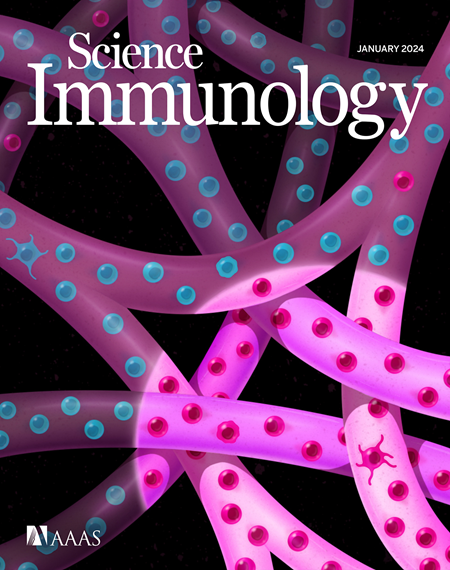ILC2和Gata3高Tregs之间的交叉对话在局部限制了适应性2型免疫。
IF 17.6
1区 医学
Q1 IMMUNOLOGY
引用次数: 0
摘要
调节性 T 细胞(Tregs)可控制适应性免疫并抑制过敏性疾病中的 2 型炎症。白细胞介素-33能促进组织驻留的Tregs和第2群先天性淋巴细胞(ILC2s)的扩增;然而,Tregs如何在炎症龛位内协调其功能尚不清楚。在这里,我们发现 ILC2 是 Treg 功能的关键协调者。通过对 2 型炎症龛的空间、细胞和分子剖析,我们发现 ILC2 和 Tregs 进行了直接(OX40L-OX40)和趋化依赖性(CCL1-CCR8)的细胞对话,从而加强了 Gata3 高的 Tregs 的局部聚集,这些 Tregs 在转录和功能上都适应了 2 型环境。ILC2-Treg交流的基因中断导致过敏原暴露后2型肺炎症失控。从机理上讲,我们发现 Gata3high Tregs 可以调节成本刺激分子 OX40L 的局部生物利用度,从而控制效应记忆 T 辅助 2 细胞的数量。因此,ILC2-Treg相互作用是控制适应性2型免疫的关键反馈机制。本文章由计算机程序翻译,如有差异,请以英文原文为准。
Cross-talk between ILC2 and Gata3high Tregs locally constrains adaptive type 2 immunity
Regulatory T cells (Tregs) control adaptive immunity and restrain type 2 inflammation in allergic disease. Interleukin-33 promotes the expansion of tissue-resident Tregs and group 2 innate lymphoid cells (ILC2s); however, how Tregs locally coordinate their function within the inflammatory niche is not understood. Here, we show that ILC2s are critical orchestrators of Treg function. Using spatial, cellular, and molecular profiling of the type 2 inflamed niche, we found that ILC2s and Tregs engage in a direct (OX40L-OX40) and chemotaxis-dependent (CCL1-CCR8) cellular dialogue that enforces the local accumulation of Gata3high Tregs, which are transcriptionally and functionally adapted to the type 2 environment. Genetic interruption of ILC2-Treg communication resulted in uncontrolled type 2 lung inflammation after allergen exposure. Mechanistically, we found that Gata3high Tregs can modulate the local bioavailability of the costimulatory molecule OX40L, which subsequently controlled effector memory T helper 2 cell numbers. Hence, ILC2-Treg interactions represent a critical feedback mechanism to control adaptive type 2 immunity.
求助全文
通过发布文献求助,成功后即可免费获取论文全文。
去求助
来源期刊

Science Immunology
Immunology and Microbiology-Immunology
CiteScore
32.90
自引率
2.00%
发文量
183
期刊介绍:
Science Immunology is a peer-reviewed journal that publishes original research articles in the field of immunology. The journal encourages the submission of research findings from all areas of immunology, including studies on innate and adaptive immunity, immune cell development and differentiation, immunogenomics, systems immunology, structural immunology, antigen presentation, immunometabolism, and mucosal immunology. Additionally, the journal covers research on immune contributions to health and disease, such as host defense, inflammation, cancer immunology, autoimmunity, allergy, transplantation, and immunodeficiency. Science Immunology maintains the same high-quality standard as other journals in the Science family and aims to facilitate understanding of the immune system by showcasing innovative advances in immunology research from all organisms and model systems, including humans.
 求助内容:
求助内容: 应助结果提醒方式:
应助结果提醒方式:


